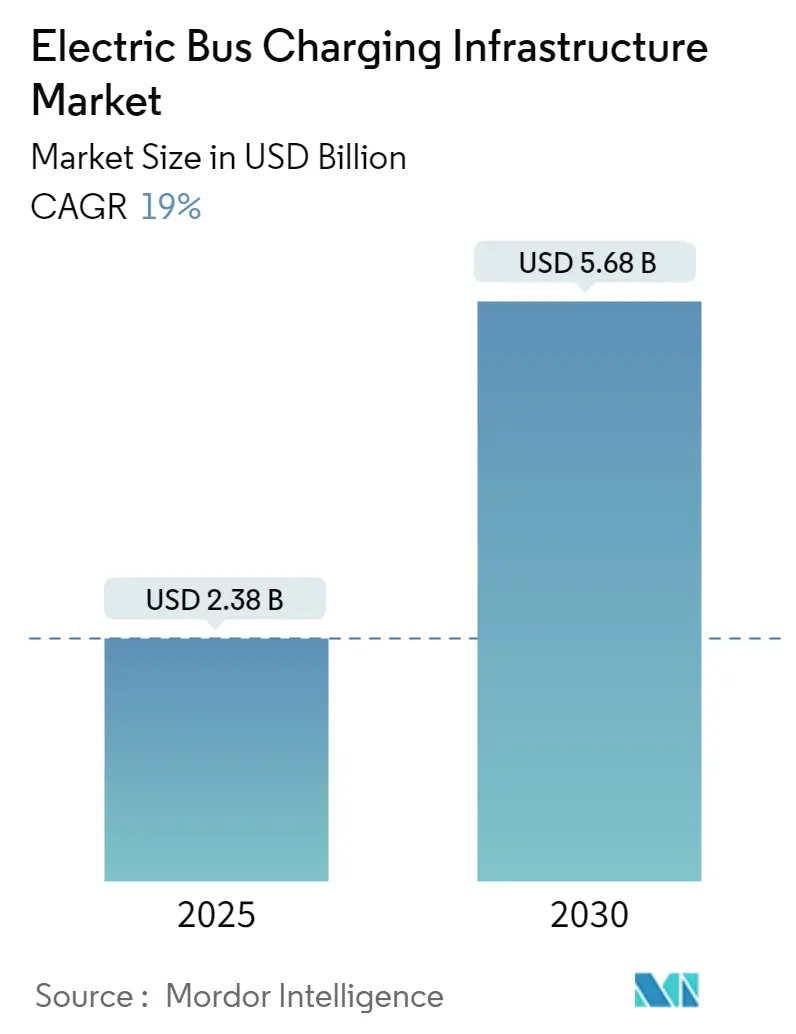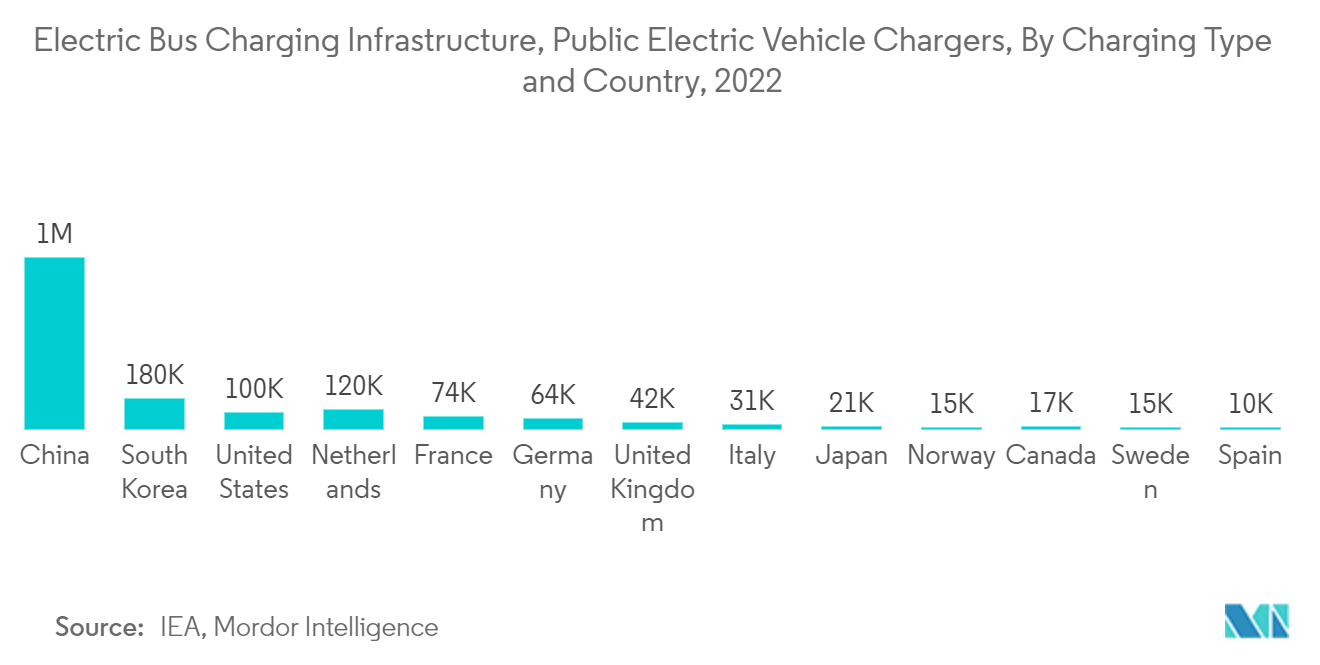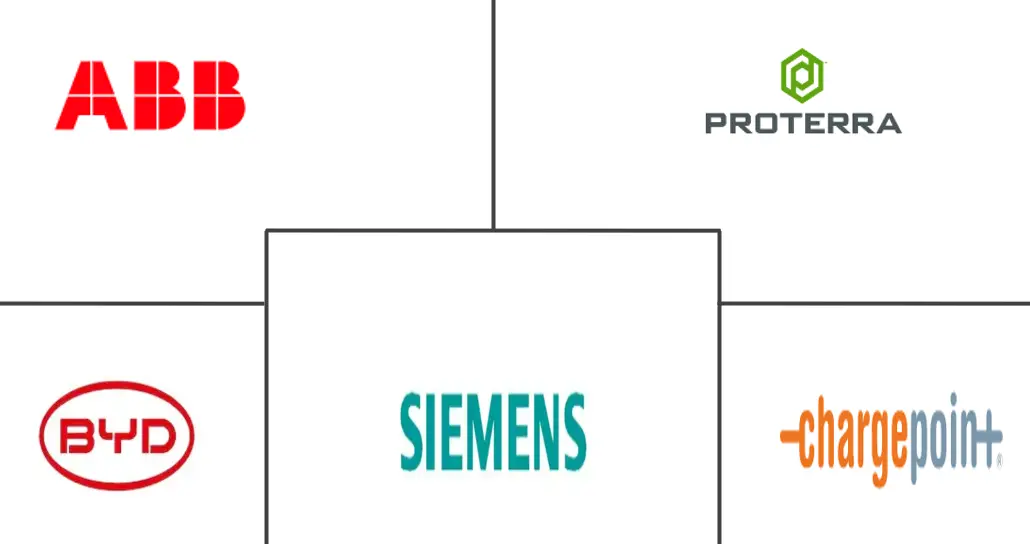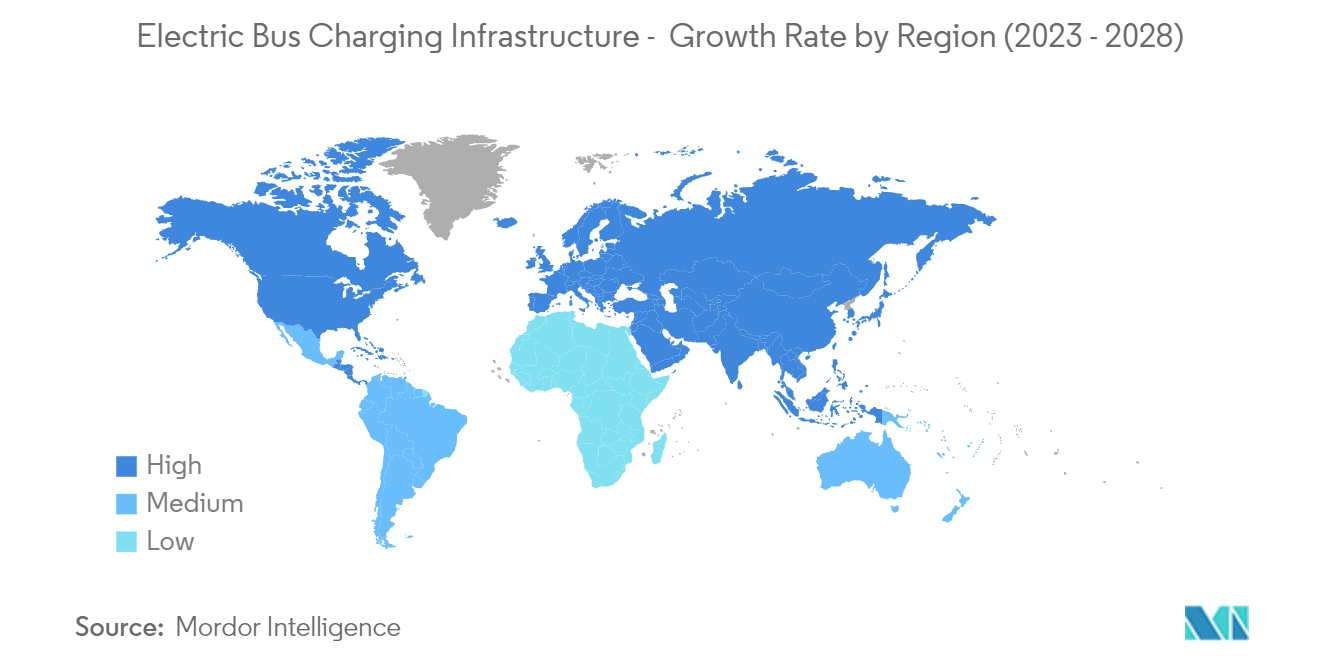
Electric Bus Charging Infrastructure Market Analysis
The Electric Bus Charging Infrastructure Market size is estimated at USD 2.38 billion in 2025, and is expected to reach USD 5.68 billion by 2030, at a CAGR of 19% during the forecast period (2025-2030).
- At the beginning of 2020, the automotive goods and supply chain market were drastically impacted by COVID-19. Also, travel restrictions and lockdowns resulted in a slowdown in electric vehicle sales. However, the automotive industry is now recovering from the losses and paving the way to introduce quality products to cater to the rising demand from consumers across the region. The automotive industry witnessed significant growth in terms of the production of electric vehicles in 2022, which is likely to increase the demand for electric buses during the forecast period.
- Over the medium term, Growing electric vehicle charging infrastructure across the globe is likely to witness significant demand for electric buses across the major regions. The rapid expansion of electric bus manufacturers across the globe is likely to propel the market during the forecast period.
- The global adoption of stricter pollution regulations is expected to boost electric car sales throughout the projection period. To meet the growing demand for electric vehicles (EVs), manufacturers of automotive power modules have begun investing in expanding their production capacities, primarily in the Asia-Pacific region, which has the world's highest sales and export of vehicles, as well as the lowest tariff on EV parts among ASEAN countries.
- In September 2022, A pilot project through which the Ministry of Road Transport & Highways in India is developing EV charging stations across 5000km of the national highway is presently in its last stages of technical and commercial testing using electric buses on the Delhi-Jaipur line beginning September 9th, 2022. This will add a 278 km length to the previously performed 210 km trial run between Delhi and Agra in 2021, completing technical testing of a total of 500 miles across four states in its pilot phase: UP, Delhi, Haryana, and Rajasthan.
- Electric buses are becoming more financially viable with favorable policies, and they generate fewer maintenance costs with substantially reduced fuel costs. According to electric bus manufacturers, electric buses save USD 400,000 in fuel expenses and nearly USD 125,000 in maintenance costs, more than making up for the higher upfront cost.
- China and the United States registered higher adoption of electric buses. In the coming years, the above countries are expected to continue to deploy more electric buses, owing to strong encouragement from the governments, transit agencies, as well as other green vehicle-supporting communities and organizations.
Electric Bus Charging Infrastructure Market Trends
Governmental Efforts to Increase in the Number of Electric Buses Will Boost Overhead Charging Type
- E-mobility is currently seen as the most promising technology to reduce exhaust emissions in transportation. Electric buses are replacing conventional diesel-fueled buses at an accelerating rate that is outpacing the adoption of battery-powered cars. According to forecasts by Bloomberg New Energy Finance, by 2030, ~28% of car sales are likely to be electric vehicles, while 84% of new buses will be electric buses.
- The electric bus market is rapidly growing across the world owing to the governmental push to decarbonize public transportation in major countries. Many countries have established goals to procure electric buses. For instance,
- The Joe Biden administration has proposed a USD174 billion program to promote the adoption of electric vehicles with the goal of moving the United States toward zero-emission transportation. The major market players' innovation in the emerging heavy-duty electric bus sector is boosting the market growth of e-buses by lowering their maintenance costs and efficiency.
- China's move toward electric vehicles is expected to continue, with 420,000 new electric buses expected to be purchased by 2025. Electric bus fleets should be able to grow significantly (about 40%) as a result of market expansion and government support.
- By 2030, India wants to sell 70% of all commercial vehicles, including 40% of buses, as electric vehicles. The objective of achieving net zero carbon emissions is in line with this.
- In Europe, electric bus registrations climbed by 48% in 2021 compared to 2020. Last year, 3,282 e-buses were delivered, increasing the total number of vehicles registered on the continent to over 8,500 since 2012. The European government has formulated various policies and has started projects for building the charging infrastructure across the region, primarily to meet the electric vehicle sales target.
- Governments across nations-initiated changes in the public transportation systems by committing to electrify their bus fleets. Robust government support in the form of subsidies is helping bring the total cost of an electric bus below that of a similar diesel variant, resulting in increased adoption of electric buses across the world. For instance,
- In July 2022, The Mexican government invested USD 38 million in the development of charging infrastructure in the country.
- In July 2022, Canadian Transport Ministry announced new purchase incentives for Medium and heavy-duty zero-emission Vehicles to enhance the electric commercial vehicle sale across the country. The new purchase incentive is worth approximately 50% of the price difference between an electric vehicle and a traditional vehicle.
- The transportation sector, which contributes about 27% to Europe's total greenhouse emissions, is also a source of other dangerous emissions, like NOx. At present, approximately 725,000 buses operate in Europe, including all types of powertrains (electric and non-electric). Out of these, around 2,500 are electric buses, which indicates that the majority of them run on diesel. By 2025, public agencies must purchase "clean" buses for a quarter of all new buses under the new rules that the European Union adopted in February 2019xs.
- From 2030, the ratio will rise to one-third. As a result, bus lines will expand significantly in European cities in the coming years. The C40 Declaration for fossil-free streets has been signed simultaneously by 40 cities, including Paris, Berlin, London, Copenhagen, Barcelona, Rome, and Rotterdam, with the goal of zero-emission bus fleets by 2025.
- With the above mentioned development across the globe is likley to witness major growth for the market during the forecast period.

Asia Pacific is Leading the Electric Bus Charging Infrastructure Market
The electric bus charging infrastructure market in the Asia Pacific is led by China, followed by Europe and North America, respectively. Currently, 99% of electric buses in service are in China, due to the major air pollution problems in Chinese cities and the decision of local authorities to invest in transport that does not emit. Other developing countries like India are fueling the electric bus charging infrastructure market by adopting more electric buses in the country.
China is a key player in the global electric bus market and is home to 98% of the world's electric buses. China is anticipated to sustain its dominance during the forecast period. In March 2021, more than 421,000 electric buses were in use China, which amounts to about 99.0% of the global fleet. The keen focus on electrification of public transit with prevalent subsidies and national regulations is a major factor contributing toward the high market share of China in the global electric bus market.
China's Ministry of Transport is offering subsidies and other benefits for the development of low emission bus fleets, thereby, further positively influencing the market. For instance, 61,000 more new energy buses were sold by Chinese bus makers during 2020, despite of the pandemic.
China's electric bus expansion is expected to continue, with 420,000 additional electric buses ordered by 2025. Growth in the market and government support should also allow for a large increase in the number of electric bus fleets, which is approximately 40%.
Shenzhen and Guangzhou are leading cities in fully electric bus fleets, while more Chinese cities are expected to follow the same in coming years. During the forecast period, China may continue to witness growth in the adoption of electric buses, as more than 30 Chinese cities have made plans to achieve 100% electrified public transit by the start of 2021, including Guangzhou, Zhuhai, Dongguan, Foshan, and Zhongshan in the Pearl River Delta, along with Nanjing, Hangzhou, Shaanxi, and Shandong.
Although China is more focused on battery electric buses, there are significant number of hybrid buses in the country owing to the long-range possibilities offered by them. During the forecast period, series hybrid category is expected to account major share in hybrid bus category. Due to the ease in designing and assembling this type of powertrain, which reduces the overall cost of electric bus, more number od buses are expected to equip this type of powertrain.
Other important countries include India . However, in India, the acceptance of electric and hybrid buses is slow, primarily due to the cost factor. The average cost of hybrid or electric buses is 3-4 times higher than diesel buses. Furthermore, with the decrease in the cost of diesel, there is not much incentive for the operators to shift to hybrid or electric buses. Some cities, like Delhi and Mumbai, are using clean fuel, like CNG, for bus operations.
Thus, to make operators adopt electric buses, the Government of India unveiled the National Electric Mobility Mission Plan (NEMMP) 2020 to accelerate the growth of the electric and hybrid components of the automotive sector. It focuses primarily on fast-tracking the manufacturing and introduction of EVs in India. For instance,
- In September 2022, In India, on behalf of five state governments, CESL-Convergence Energy Services Ltd. (a subsidiary of EESL- Energy Efficiency Services Ltd.) granted a contract for 5,450 electric buses. CESL plans to conduct a $10 billion (Rs.80,000 crore) tender for 50,000 electric buses, which has been authorized by NITI Ayog to reduce pollution in India and boost E-Bus manufacturers.
Electric Bus Charging Infrastructure Industry Overview
The electric bus charging infrastructure market is consolidated and led by a few players, such as ABB Group, Proterra Inc. (also an electric bus manufacturer), ChargePoint Inc., Siemens AG, and Others. The companies are entering strategic partnerships, acquisitions, and product development to expand their brand portfolio.
In October 2022, Solaris inaugurated its new pantograph charging depot warehouse Hall and an innovative charging park in Bolechowo for electric buses. The warehouse is spread over a 10,000 m2 area and equipped with cutting-edge logistics systems and solutions.
In January 2022, Following a grant from the California Energy Commission, Proterra announced that the Santa Clara Valley Transportation Authority (VTA) will install an innovative clean energy microgrid and EV fleet charging system with Proterra and Scale Microgrid Solutions to power the organization's transition to a 100% zero-emission bus fleet. The project, which is expected to be operational by the end of 2023, demonstrates how fleet-scale EV charging and clean energy can facilitate the adoption of fully electric vehicle fleets.
In November 2021, The California Energy Commission has given the Los Angeles Department of Transportation (LADOT) a USD 6 million grant to install one of the largest EV fleet charging systems in the United States that will be powered by a solar and storage microgrid. At the Washington Bus Yard, LADOT will install a 4.5MWh Apparent energy storage system in conjunction with 1.5 megawatts of rooftop and bus solar canopy to power five Proterra 1.5 megawatt fleet chargers with 104 remote EV charging dispensers.
Electric Bus Charging Infrastructure Market Leaders
-
ABB Ltd
-
Proterra
-
ChargePoint Inc.
-
Siemens AG
-
BYD Auto Co. Ltd
- *Disclaimer: Major Players sorted in no particular order
Electric Bus Charging Infrastructure Market News
- November 2022: ABB E-Mobility, the electric vehicle charging solutions subsidiary of ABB Ltd., successfully raised CHF 200 million (USD 214 million) in a pre-IPO private placement led by a group of minority investors. The capital infusion will play a crucial role in supporting the company's growth strategy, which includes pursuing both organic and inorganic opportunities, such as potential mergers and acquisitions. The transaction is expected to be finalized in the fourth quarter of 2022.
- September 2022: ABB E-Mobility embarked on manufacturing operations in Columbia, South Carolina. This move will lead to the creation of over 100 new jobs in the area. The multimillion-dollar investment in the new facility will enable the production of electric vehicle chargers, including those complying with the Buy America Act. The plant's annual production capacity is estimated at up to 10,000 chargers, with power ranging from 20 kW to 180 kW. These chargers are specifically designed for fleets, school buses, and public charging stations, making them a valuable addition to the electric vehicle infrastructure.
- August 2022: Siemens and MAHLE Group joined forces to collaborate on cutting-edge wireless charging systems for electric vehicles. In this collaborative effort, both companies will work together to develop and test comprehensive infrastructure and automotive engineering systems. A primary focus of the partnership is to establish technological standards for inductive charging technology, paving the way for advancements in this area. The companies also plan to actively participate in coordinating standardization efforts within relevant pre-standardization and standardization bodies to drive further progress in the field.
Electric Bus Charging Infrastructure Industry Segmentation
An electric bus charging infrastructure is a kind of infrastructure that is specifically designed for the charging of electric buses. Onboard batteries, a hydrogen fuel cell, overhead wires, as in a trolleybus application, or ground-based non-contact conductors can be used as the power source.
The electric bus charging infrastructure market is segmented by Charging Type and Geography. By charging type, the market is segmented into plug-in charging and overhead charging. By geography, the market is segmented into North America, Europe, Asia-Pacific, and the Rest of the World.
For each segment, the market sizing and forecast have been done based on the value (USD).
| Charging Type | Plug-in Charging | ||
| Overhead Charging | |||
| Geography | North America | United States | |
| Canada | |||
| Rest of North America | |||
| Europe | Germany | ||
| United Kingdom | |||
| France | |||
| Italy | |||
| Spain | |||
| Rest of Europe | |||
| Asia-Pacific | China | ||
| India | |||
| Japan | |||
| South Korea | |||
| Rest of Asia-Pacific | |||
| Rest of the World | South America | ||
| Middle-East and Africa | |||
Electric Bus Charging Infrastructure Market Research FAQs
How big is the Electric Bus Charging Infrastructure Market?
The Electric Bus Charging Infrastructure Market size is expected to reach USD 2.38 billion in 2025 and grow at a CAGR of 19% to reach USD 5.68 billion by 2030.
What is the current Electric Bus Charging Infrastructure Market size?
In 2025, the Electric Bus Charging Infrastructure Market size is expected to reach USD 2.38 billion.
Who are the key players in Electric Bus Charging Infrastructure Market?
ABB Ltd, Proterra, ChargePoint Inc., Siemens AG and BYD Auto Co. Ltd are the major companies operating in the Electric Bus Charging Infrastructure Market.
Which is the fastest growing region in Electric Bus Charging Infrastructure Market?
Europe is estimated to grow at the highest CAGR over the forecast period (2025-2030).
Which region has the biggest share in Electric Bus Charging Infrastructure Market?
In 2025, the Asia Pacific accounts for the largest market share in Electric Bus Charging Infrastructure Market.
What years does this Electric Bus Charging Infrastructure Market cover, and what was the market size in 2024?
In 2024, the Electric Bus Charging Infrastructure Market size was estimated at USD 1.93 billion. The report covers the Electric Bus Charging Infrastructure Market historical market size for years: 2019, 2020, 2021, 2022, 2023 and 2024. The report also forecasts the Electric Bus Charging Infrastructure Market size for years: 2025, 2026, 2027, 2028, 2029 and 2030.
Our Best Selling Reports
Electric Bus Charging Infrastructure Industry Report
Statistics for the 2025 Electric Bus Charging Infrastructure market share, size and revenue growth rate, created by Mordor Intelligence™ Industry Reports. Electric Bus Charging Infrastructure analysis includes a market forecast outlook for 2025 to 2030 and historical overview. Get a sample of this industry analysis as a free report PDF download.





